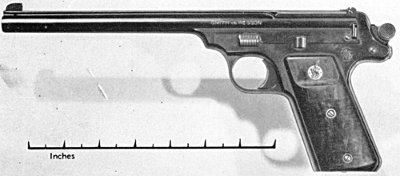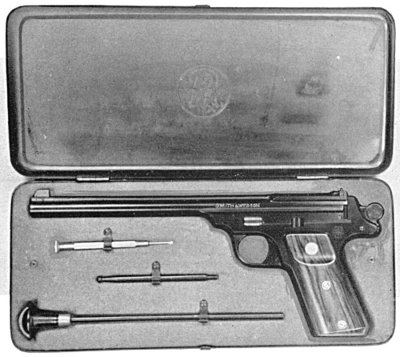The following information on the Smith & Wesson Straight Line Single Shot target pistol comes from Smith & Wesson Hand Guns by Roy C. McHenry and Walter F. Roper. Smith & Wesson Hand Guns is also available to purchase in print.
Smith & Wesson .22 single-shot target pistols had held world records for many years when the firm announced suddenly in 1923 that the Olympic Model was to be retired in favor of a new model. To the initial surprise of the single-shot fraternity was added dismay when the new Straight Line Single-Shot pistol was unveiled.
Except that it had a 10-inch barrel, it bore not the slightest resemblance to its predecessors. Gone were the graceful and familiar curves of the Olympic Model, which had evolved naturally out of the single-action revolver, and in their place was a combination of straight lines and sharp angles. The stock was a slanted parallelogram, suggestive of the Clement-Smith & Wesson automatic, and its action was opened by half-cocking and swinging the barrel to the right on a pivot like some of the early cartridge derringers.

Instead of swinging in an arc, the hammer struck the cartridge with a plunger movement. Over-all weight of the new model was 34 ounces, exceeding by almost a pound the weight of the Olympic or Perfected Model single-shot. It was an excellent job from a mechanical standpoint, and the firm obviously had put its heart into the gun as well as a large investment necessary to produce such a radically different weapon.

Actually it was produced as an answer to the Colt Camp Perry Model single-shot, which made use of the Colt Officers Model .38 frame and had achieved great success in 1921 and 1922. The Straight Line Model had the same weight as the Camp Perry and was described by the catalogue in the following terms:
“…we determined to design an arm which would be easier for the average man to shoot well, and at the same time make several desirable improvements in the action.
“To this end we adapted the type of handle typical of the Auto Pistol, as when shot with the arm extended this shape makes the pistol point naturally without any bending of the wrist. Those who have learned to do deliberate shooting with a revolver or with our old model pistol will find this auto-shaped grip a very different proposition—but after a little practice, scores will begin to improve and shooting will be much easier, and require much less holding for each shot.
“For years expert pistol marksmen have criticized the swinging hammer and trigger on the ground that they tended to disturb the aim. To overcome this we have used a straight pull trigger and a hammer that moves in a straight line parallel to the bore.”
Many Straight Line Models were purchased by slow fire experts when they first went on the market and the veterans found that the catalogue had correctly called the auto-shaped grip a “very different proposition.” They tried patiently to master the new technique and to unlearn what had taken them years to acquire.
But after much practice and the expenditure of ammunition in case lots, their scores failed to improve as the book had promised, and with few exceptions they went back to shooting their Olympic Models.
Nobody seems to know just what was wrong with the Straight Line Model; and, for that matter, the problem has yet to be solved. In his Textbook of Pistols and Revolvers, Colonel Hatcher suggests that the reach to the trigger is too short and that the angle of the grip is such that the barrel has a natural tendency to point downward when the arm is extended toward the target. To correct either of these alleged faults would be an expensive proposition.
Several pistol experts succeeded in compiling good scores with the Straight Line, but they were greatly in the minority. Sales dropped precipitately after the first rush, and a few years later the model was eliminated from the catalogue although a number remained in the hands of some of the larger wholesalers. The Straight Line Model is a sore point with Smith & Wesson and they have never revealed how many were built.
At present the firm is not making any single-shot pistol, but if they return such a model to production they might very well consider the suggestions made a number of years ago by the late Henry Walter Fry.
Fry pointed out that the Olympic Model was too lightly constructed and suggested that the frame of the famous Russian Model .44 revolver be combined with a .22 barrel of appropriate weight and length, utilizing the loading and ejecting system of the Olympic Model as well as its particularly excellent design of lock work. Of course, the faults ascribed by the catalogue to the swinging hammer would remain, but they could be reduced to a minimum by shortening the hammer throw. At least the idea deserves a test, by Smith & Wesson or any other firm, and with a recessed gun chambering the hi-speed cartridges, the possibilities for long range shooting would be great.

[…] And here's an article that you may also find interesting . Smith & Wesson Straight Line Single Shot Target Pistol Regards George -I never heard of the dog-gone thing before either ………. First […]